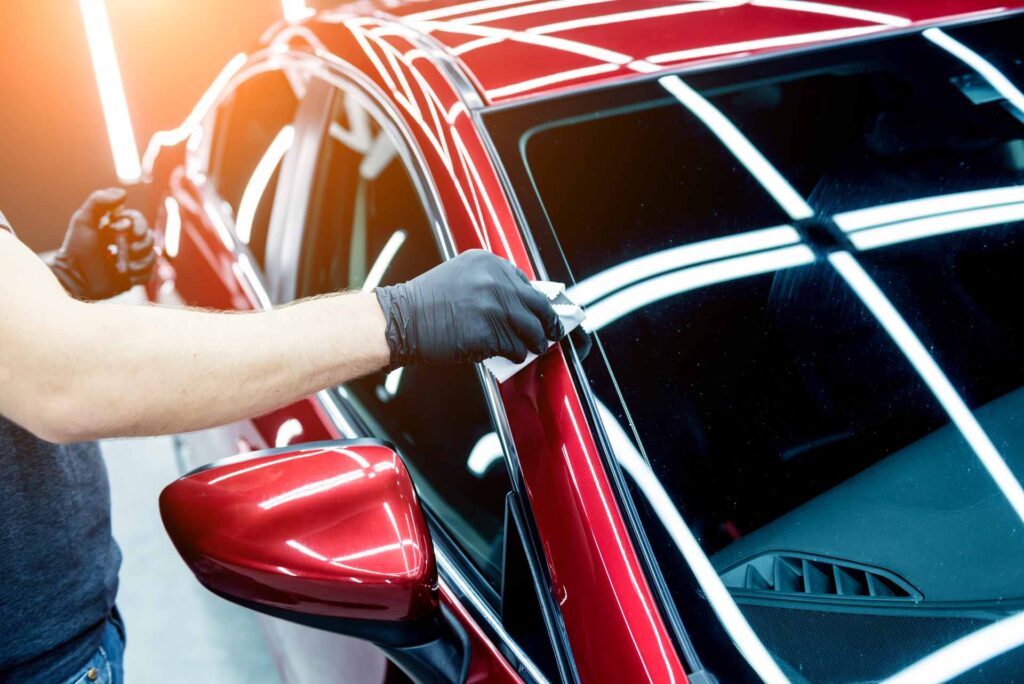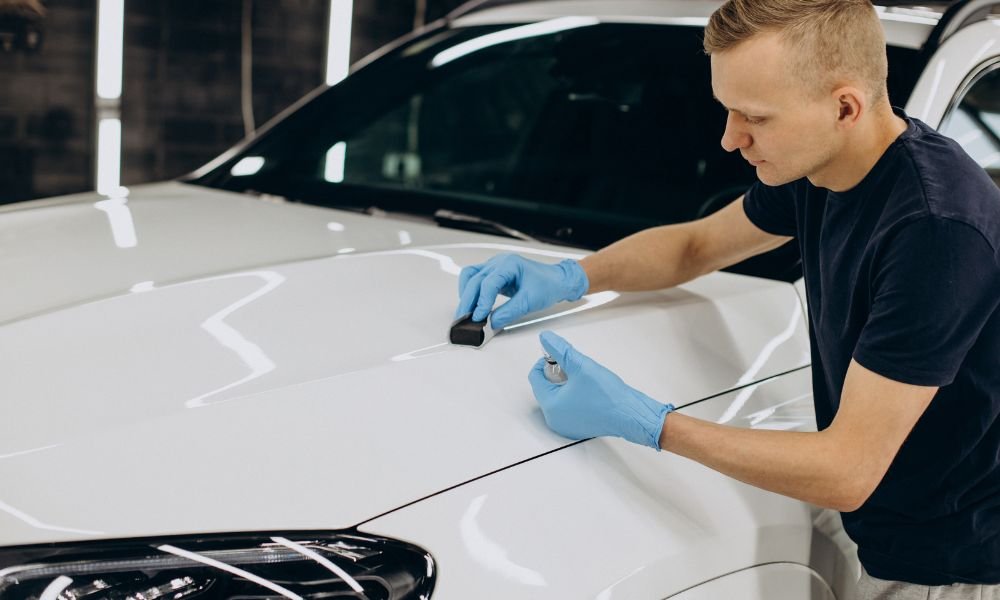Ceramic Coating vs. Sealants: Recognizing the Distinctions for Your Auto
Ceramic Coating vs. Sealants: Recognizing the Distinctions for Your Auto
Blog Article
The Significance of Ceramic Coating: Shielding Your Vehicle's Exterior With Accuracy
In an age where maintaining the practical and aesthetic stability of your vehicle is paramount, ceramic finish emerges as an essential solution. With its distinct bonding residential or commercial properties, ceramic layer uses a level of defense that far goes beyond standard waxing approaches.
Advantages of Ceramic Coating
When it involves maintaining a cars and truck's visual charm, ceramic finish provides considerable benefits. This sophisticated safety layer supplies a sturdy guard versus ecological impurities, consisting of dust, crud, and unsafe UV rays. By forming a semi-permanent bond with the vehicle's paint, ceramic finishings efficiently avoid oxidation and fading, making sure that the auto keeps a glossy, showroom-like coating for an extended period. This not only boosts the car's visual allure yet additionally adds to its long-lasting worth.
Along with its protective qualities, ceramic layer supplies exceptional hydrophobic residential properties, triggering water and various other liquids to grain off easily. This feature streamlines the cleaning procedure, as dust and particles are less most likely to abide by the surface, minimizing the frequency and initiative required for upkeep. The coating's resistance to chemical stains from acidic impurities like bird droppings and tree sap is one more significant benefit, lessening potential paint damages.
Ceramic finishings also enhance scrape resistance, offering a layer that can soak up minor abrasions and swirl marks. This quality is specifically helpful in maintaining an immaculate surface area, reducing the possibility of visible flaws and maintaining the stability of the automobile's paintwork with time.

Exactly How Ceramic Coating Works
Comprehending the auto mechanics behind ceramic finishing reveals its efficacy as a safety remedy for automobiles. Ceramic finishes are essentially liquid polymer applications that chemically bond with a cars and truck's manufacturing facility paint, producing a protective layer.
Application of ceramic coating entails a thorough process. The lorry's surface have to be extensively cleansed and decontaminated to make certain optimum attachment. When used, the liquid polymer develops a semi-permanent bond with the paint, solidifying into a clear, sturdy guard. This guard boosts the car's gloss and hydrophobic residential properties, assisting in easier cleansing by triggering water and contaminants to grain and slide off easily.
Additionally, the coating's molecular framework gives resistance to minor scrapes and chemical discolorations. Unlike waxes or sealants that rest on top of the paint, ceramic finishings integrate with the surface, using lasting defense. This integration is essential to its performance, ensuring the automobile's coating continues to be pristine for years.
Contrasting Ceramic Coating to Alternatives
In the world of vehicle defense, ceramic layer stands as a formidable choice when contrasted to typical alternatives such as waxes and sealants. While waxes provide a momentary shiny finish, generally lasting just a couple of weeks to months, ceramic coverings offer a longer-lasting solution, typically withstanding for many years. This sturdiness is associated to the chemical bonding that happens when ceramic coverings are applied, forming a strong layer that is immune to ecological risks.
Contrastingly, sealants, although more durable than waxes, still disappoint the durable defense used by ceramic finishes. Sealants can typically last for up to a year, giving an artificial shield versus specific elements. Nonetheless, they do not have the remarkable hydrophobic properties and UV defense that ceramic finishes deliver.
In addition, ceramic layers provide enhanced scratch resistance, which neither waxes nor sealers can effectively match. In recap, while typical waxes and sealants supply basic protection, ceramic finishes offer a comprehensive, long-lasting service that dramatically protects the automobile and improves's outside coating.
Application Process Explained
Applying ceramic finish to a car requires a thorough procedure to make certain optimal outcomes and resilience. The initial action involves thoroughly cleaning the car's surface to get rid of dirt, oil, and previous waxes. This is crucial for guaranteeing the covering adheres effectively. A pH-neutral hair shampoo and a clay bar therapy are often utilized to accomplish a beautiful surface. When cleaned, the vehicle is dried and brightened to get rid of any flaws, as any type of existing scratches or swirls can come to be extra noticable after the finishing is applied.
Adhering to why not look here surface preparation, the application of the ceramic layer starts. Using an applicator pad, the ceramic finish is applied in little sections to ensure even insurance coverage.
After application, the covering needs a details curing duration, during which the car ought to be secured from water and impurities. This curing process can differ depending on the item but usually ranges from 24 to 48 hours. Eventually, this in-depth procedure is crucial in achieving a glossy and resilient surface.
Maintenance Tips for Long Life
To maintain the long life of article a ceramic coating, adherence to a disciplined upkeep regimen is important. Avoid automated auto cleans, as their extreme brushes can jeopardize the finishing's stability.
Post-wash, drying out the lorry with a tidy microfiber towel stops water spots that may weaken the finish in time. In addition, use a ceramic finishing booster every few months. These boosters enhance the hydrophobic properties and boost the covering's protective abilities, ensuring it continues to be efficient against impurities.
Remember that car parking locations play an important role in upkeep. ceramic coating. Whenever possible, park in shaded locations to decrease UV direct exposure, which can gradually damage the covering. For lasting storage, take into consideration using a vehicle cover for included security versus ecological elements
Final Thought
In conclusion, ceramic layer offers as an essential safety layer for vehicle outsides, providing resilient protection against ecological factors such as uv, dirt, and gunk rays. By forming a semi-permanent bond with the paint, it improves aesthetic charm while maintaining the automobile's worth. Its hydrophobic residential or commercial properties facilitate easier upkeep, identifying it from alternative safety approaches. Comprehending the application process and adhering to maintenance suggestions are essential for making best use of the longevity and effectiveness of ceramic finishing.
When it comes to protecting an automobile's aesthetic appeal, ceramic finishing provides considerable advantages. By forming a semi-permanent this article bond with the lorry's paint, ceramic coatings properly protect against oxidation and fading, ensuring that the car maintains a shiny, showroom-like surface for a prolonged period. Ceramic layers are basically liquid polymer applications that chemically bond with an automobile's factory paint, developing a safety layer. In summary, while typical waxes and sealers provide standard security, ceramic finishings present a thorough, long-lasting service that significantly boosts and protects the car's outside finish.

Report this page